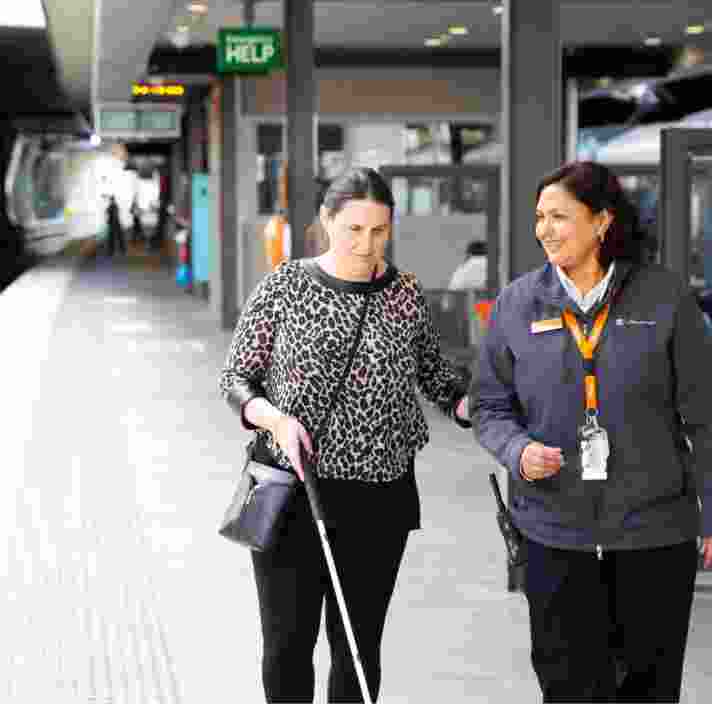On this page:
An introduction to the guiding techniques
How to guide someone.
People with low vision sometimes require assistance to move safely through the community. The aim of providing guidance is to assist a person so they can travel confidently and efficiently as necessary in certain situations. These can include general travel, and more specific instances like using escalators or getting into vehicles.
Remember, not every person with low vision will need this type of assistance. You should always ask for the best way to assist each individual.

General guiding practices
Best practice for guiding a person with low vision or blindness.
-
Establish contact
Introduce yourself, even if you are known to the person. Ask if they need assistance and whether they would like to be guided to a destination. If they do, make contact by touching the back of your hand against the back of theirs. This is a signal for them to take your arm. -
Grip
Let the person with low vision or blindness take hold of your arm just above the elbow – with their four fingers on the inside and thumb on the outside of your arm. Their grip should be firm but not tight enough to cause you discomfort. -
Alternative grip
Linking arms may be preferable for elderly people, or people with problems balancing. Gripping the wrist may be more comfortable for a child or where there is substantial height difference. A person may prefer to place a hand on the shoulder. -
Stance
Keep your arm relaxed. The person with low vision's arm should also be relaxed, bent at about 90 degrees and held close to their side. They should stand beside you, about half a pace behind. -
Walking
As you walk together, alert the person to any upcoming obstacles. These can include overhanging branches, changes in direction, or different textures under foot. -
Narrow passages
Inform the person if you are approaching a narrow passage, or an environment where walking side-by-side is impractical. Move your arm backwards and position it diagonally across your back. The person with low vision will straighten their arm and step directly behind you. Their arm must remain extended to prevent you from tripping over each other’s feet. Inform the person when you have passed through the environment so they can resume the original position. -
Doorways
The person with low vision must be on the hinge side of the door. If they are not on the hinge side, ask them to change sides. Tell the person whether they are dealing with a push or pull door. Place your hand on the handle and allow the person to move their hand down your arm towards the door handle. Open the door and go through first, allowing the person with low vision to close the door behind you. -
Stairs and escalators
Always approach stairs and escalators from directly in front. Pause where they begin. Inform the person if the stairs go up or down. Tell the person where the hand rail is and allow them to move to that side. Stay one step ahead of the person on the stairs and walk together in rhythm. Inform the person when you have reached the end of the stairs, or tell the person you are about to step off the escalator: for example, in three seconds. -
Getting into a chair
Place the person with low vision’s hand onto the back rest of the chair. Tell them which direction the chair is facing. The person will use their hands to explore the chair and seat themselves. Never push a person with low vision into a seat. -
Getting into a car
Bring the person to the door. Tell them which way the car is facing and whether it is a front or rear door. Place one of their hands on the door handle and let them open the door. Place their other hand on the top corner of the door. The person can then reach across and locate the roof, remaining in contact with it until their head is in the car.
Working alongside people with low vision
Be mindful of the following techniques if you meet or work alongside a person with low vision.
-
Declare yourself
Address the person by name and introduce yourself, as well as any other people in the room. Be prepared to shake hands upon meeting or leaving if the person extends their hand. Announce your status when entering or leaving a room. -
Don't presume
Only a small percentage of people are blind or see nothing at all. Don’t presume that a person with low vision cannot see you at all. Don’t presume that you know what a person with low vision looks like. Not all eye or neurological conditions that can cause low vision or blindness are outwardly obvious.Don’t presume that a person with low vision needs help. If in doubt, ask them. Don’t presume that a person with low vision has heightened senses. Using the other senses is a learned skill that requires specific training. -
Speak naturally
Feel free to use words like ‘look’, ‘see’ and ‘sight’. These are commonly used by people with low vision. Avoid shouting, address the person naturally and speak face-to-face. Never ask a third person what a person with low vision wants or needs; speak directly to them. -
Be specific
Avoid using vague words: ‘here’ or ‘over there’. If pointing, check that the person can see your hand. When using terms like ‘left’ or ‘right’, be sure that they relate to the person with low vision. You can also use the positions of a clock face to describe directions. For example, your drink is at ‘twelve o’clock’. -
Ask first
If a person with low vision appears to need assistance, confirm by asking: ‘may I help you?’ Do not grab or touch a person with low vision without warning. If your offer is accepted, touch your hand against the back of the person’s hand and let them take your arm. -
Guide wisely
When guiding a person with low vision, ask what kind of information may be useful. Some people like to be told about approaching steps, doorways or surfaces, while others are happy to read the guide’s body language. Avoid sudden movements while guiding a person with low vision. -
Maintain a safe environment
Do not leave doors ajar. Inform the person with low vision of any changes of furniture placement in a room. Don’t leave objects on the floor and return things to their original place. -
Respect Guide Dogs
Do not pat, feed, or distract a Guide Dog in a harness. It can be damaging for their training.
Ready to continue?
Seems like you have filled this form earlier. Let’s pick up where you left off.
